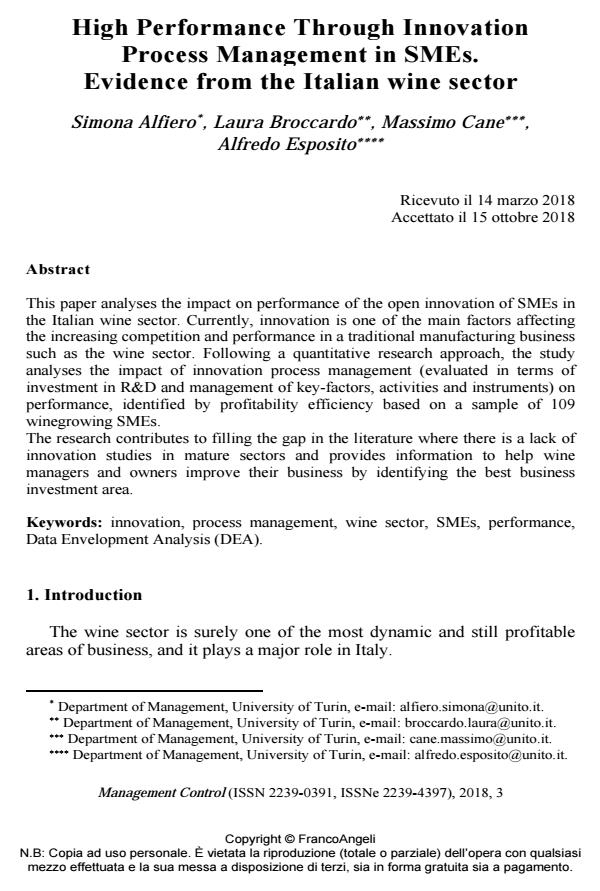High Performance Through Innovation Process Management in SMEs. Evidence from the Italian wine sector
Journal title MANAGEMENT CONTROL
Author/s Simona Alfiero, Laura Broccardo, Massimo Cane, Alfredo Esposito
Publishing Year 2018 Issue 2018/3
Language English Pages 24 P. 87-110 File size 284 KB
DOI 10.3280/MACO2018-003005
DOI is like a bar code for intellectual property: to have more infomation
click here
Below, you can see the article first page
If you want to buy this article in PDF format, you can do it, following the instructions to buy download credits

FrancoAngeli is member of Publishers International Linking Association, Inc (PILA), a not-for-profit association which run the CrossRef service enabling links to and from online scholarly content.
This paper analyses the impact on performance of the open innovation of SMEs in the Italian wine sector. Currently, innovation is one of the main factors affecting the increasing competition and performance in a traditional manufacturing business such as the wine sector. Following a quantitative research approach, the study analyses the impact of innovation process management (evaluated in terms of investment in R&D and management of key-factors, activities and instruments) on performance, identified by profitability efficiency based on a sample of 109 winegrowing SMEs. The research contributes to filling the gap in the literature where there is a lack of innovation studies in mature sectors and provides information to help wine managers and owners improve their business by identifying the best business investment area.
Keywords: Innovation, process management, wine sector, SMEs, performance, Data Envelopment Analysis (DEA).
- Sustainable Business Model and the Firm Age Variable Impact: Evidence from wine industry Simona Alfiero, Laura Broccardo, Massimo Cane, in MANAGEMENT CONTROL 3/2024 pp.165
DOI: 10.3280/MACO2023-003008 - L'approccio integrato al controllo aziendale in un periodo di crisi "eccezionale". Il caso del Gruppo Farnese Barbara Iannone, Carlo Piretti, in MANAGEMENT CONTROL 1/2021 pp.81
DOI: 10.3280/MACO2021-001005 - Tecnologías de la información, la comunicación y comportamiento innovador en MiPyMEs vitivinícolas del Valle de Guadalupe, México Andrés Antonio Luna Andrade, Ricardo Luna Andrade, Gina García Walther, in Revista Venezolana de Gerencia /2025 pp.1709
DOI: 10.52080/rvgluz.30.112.1 - The impact of digitalisation on professional football clubs Fabio Nappo, Alessandra Lardo, Maria Teresa Bianchi, Federico Schimperna, in MANAGEMENT CONTROL 2/2023 pp.117
DOI: 10.3280/MACO2023-002006 - “Organizational Culture and Innovative Behavior in Wine SMEs: Case Study in Valle de Guadalupe, Mexico” Andrés Antonio Luna Andrade, Lino Meraz Ruiz, Omar Alejandro Pérez-Cruz, Gina García Walther, Luz Alejandra Riveros Sáchica, in Wine Economics and Policy /2025
DOI: 10.36253/wep-16724
Simona Alfiero, Laura Broccardo, Massimo Cane, Alfredo Esposito, High Performance Through Innovation Process Management in SMEs. Evidence from the Italian wine sector in "MANAGEMENT CONTROL" 3/2018, pp 87-110, DOI: 10.3280/MACO2018-003005